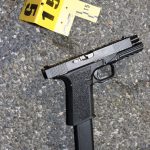Report of the Department of Justice on September 9, 2022 Use of Force by New Castle County Police Department
Scope of Investigation
This is the final report of the Delaware Department of Justice, Division of Civil Rights and Public Trust (“DCRPT”), arising out of the investigation into the use of deadly force, via non-fatal shooting, by the New Castle County Police (“NCCPD”) against Portia Herndon (hereinafter “Herndon”). DCRPT reviewed evidence consisting of video footage, dispatch recordings, witness interviews, police interviews, scene photos, police reports, medical records, and forensic firearms reports. Attorneys with DCRPT reviewed this use of force incident for the Department of Justice.
This report is the seventh (7th) report by DCRPT on a case involving a pending criminal defendant.1 As our reports seek to expand transparency and ensure trust in the process of reviewing the deadly use of force by law enforcement, we must stress that this report is wholly separate from the criminal proceeding – DCRPT’s investigators and prosecutors are not involved in the criminal case, nor are Criminal Division prosecutors involved in DCRPT’s decision-making. The outcome of Herndon’s criminal case must be determined solely and exclusively on the evidence presented at trial, and in accordance with the Court’s rules. This report in no way relieves the State of Delaware of its burdens at trial.
Purpose of the Department of Justice Report
The Department of Justice determines whether a law enforcement officer’s use of deadly force constitutes a criminal act. The Department of Justice does not establish or enforce internal police policies concerning the proper use of deadly force by law enforcement officers. Law enforcement agencies are responsible for establishing and enforcing guidelines for the use of force by their officers and for determining whether an officer’s actions were consistent with such guidelines in a given case. This report expresses no opinion whether involved officers’ actions complied with departmental policies or procedures.
Facts
Portia Herndon and Victim One (“V1”) began dating on or about October 23, 2021. Later, around July 31, 2022, they moved in together at the residence of V1. Herndon, due to a dispute involving V1 spending time with another person, moved out of the apartment. Their relationship dissolved around August 18, 2022.
V1 knew that Herndon carried a polymer 9mm handgun that lacked a serial number (also known as a “ghost gun”).2 During a 2021 incident investigated by New Castle County PD, this gun was confiscated from Herndon by police but was later returned after it was determined that a gunshot Herndon fired in the air was done in defense of V1. Ballistic testing of the handgun Herndon used in the instant shooting confirms it is the same weapon recovered by the police in the 2021 case.
On September 9, 2022, just after 2:30 p.m., V1 called 911 and reported that Herndon was knocking on the door of her residence and had been doing so for approximately three hours. NCCPD responded and Herndon retrieved some belongings and departed.3
At approximately 8:00 p.m., V1’s mother (Victim Two, “V2”) arrived to pick up V1 and her two sons. Herndon was aware V1 would be departing the residence at this time because the two exchanged text messages regarding property that was left outside for Herndon to pick up.
As V1, V2, and the children entered V2’s vehicle, they discovered the tires were slashed. V1 was attempting to contact Herndon via Facetime when Herndon arrived in her vehicle, a gray Chevrolet Malibu, and parked in the area of V2’s vehicle. As Herndon exited her vehicle, V1 observed Herndon place a handgun in her pants pocket.4 V2 asked Herndon not to touch V1. Herndon replied that she was not going to hurt V1, but Herndon asked V1 to stop video recording.
At some point during their conversation, Herndon discharged a round from her handgun that V2 describes as being fired “to the left.” V1 called her father and V2 called 911. V1’s father, Person One, also called 911. Person One, who lives in Virginia, called the New Castle County 911 center and, among other things, advised police dispatchers that Herndon was armed with a 9mm handgun and was threatening to shoot the victims if they called the police. Person One provided the description of Herndon’s and V2’s vehicles and their approximate location. Multiple NCCPD officers were dispatched to the incident.
As NCCPD officer Corporal Brooks Fitzpatrick arrived on scene, he heard what he believed to be a gunshot. Cpl. Fitzpatrick stopped his fully marked NCCPD Tahoe and looked around for the source of the gunshot. It was at this point he looked in the direction of a dark colored Chevrolet and observed V1 kneeling on the ground with her hands in the air. Herndon was standing in front of V1 in a posture that Cpl. Fitzpatrick believed was that of someone preparing to execute someone. He then observed Herndon fire what he believed to be three shots at V1. Cpl. Fitzpatrick began firing at Herndon. According to Cpl. Fitzpatrick, Herndon shifted her attention to him and began advancing on him (still armed). Cpl. Fitzpatrick moved and took cover behind a vehicle which was parked approximately perpendicular to his patrol vehicle. On footage from Cpl. Fitzpatrick’s body worn camera (BWC), a gunshot is heard that caused Cpl. Fitzpatrick to duck. No other officers were on scene at this point. Cpl. Fitzpatrick continued to change locations and fire. Herndon went down but was not complying with Cpl. Fitzpatrick’s commands and was still believed to be armed. Officer Christopher Knight arrived on scene and also began firing his departmental issued handgun at Herndon. Herndon stopped moving, which caused both officers to cease firing. Ofc. Knight believed he observed Herndon’s weapon laying on the ground. Cpl. Fitzpatrick updated RECOM that there were two subjects down (Herndon and V1), and that the exact location of Herndon’s firearm was unknown, but it was possibly out of her reach. Additional officers arrived on scene, formed an arrest team, and took Herndon into custody without further incident.
Officers then began administering aid to both V1 and Herndon. Both subjects were transported by ambulance to Christiana Hospital for treatment. No officers were injured in the exchange of gunfire with Herndon.
Witness One (“W1”) was located. W1 witnessed the incident from the point Herndon shot V1 through her exchange of gunfire with police. W1 described a subject that was consistent with Herndon in physical appearance. W1 stated he observed the subject shoot a female (V1). Once police arrived on scene, he heard an officer yelling commands at the subject who then took aim at police and began firing. The officer returned fire at the subject. W1 then gathered his child and fled the building.
Police Witnesses
Corporal Brooks Fitzpatrick
Cpl. Fitzpatrick has been with the New Castle County Police Department since April of 2012. On September 9, 2022, Cpl. Fitzpatrick was assigned to uniformed patrol, D Squad. Cpl. Fitzpatrick was working the night shift from 3 p.m. to 2:15 a.m.
Prior to the shooting, Cpl. Fitzpatrick had responded to Fairway Road at approximately 4 p.m. in reference to what initially was described as a domestic dispute. The caller reported that their ex-girlfriend was at the residence and knocking at the door. The caller was not letting the ex-girlfriend inside.
When Cpl. Fitzpatrick arrived, he approached the caller’s second floor apartment where he observed Officer Gregory Moserowitz who had also been dispatched to the complaint. Cpl. Fitzpatrick also observed the person who was identified by the caller as the ex-girlfriend. This individual identified herself as Portia, and she was sitting on the steps next to Officer Moserowitz.
Herndon indicated that she was there to gather belongings from the residence. Cpl. Fitzpatrick then knocked on the door and contacted the caller who identified herself as V1. V1 confirmed that she did have some of Herndon’s belongings, which consisted of several jackets, a coffee maker, and a set of speakers. V1 said that she did not want Herndon to enter her apartment but did not specify as to why. V1 gathered Herndon’s jackets and coffee maker and placed them in the doorway so Herndon could transport the items to her vehicle. Cpl. Fitzpatrick described the call as routine and told investigators that he goes to similar calls on a regular basis.
When Cpl. Fitzpatrick received the call that brought him back to Fairway Road later that same evening, Cpl. Fitzpatrick was sitting in what he described as a vacant driveway on Polly Drummond Hill Road across from Zingo’s Supermarket. The call was for the address of 46 Fairway Road which he immediately recognized as an address that he had responded to earlier in the day. The caller advised that her ex-girlfriend or daughter’s ex-girlfriend was at the residence, had slashed her tires, and threatened her with a handgun.
Cpl. Fitzpatrick estimated that he was approximately two to three minutes from 46 Fairway Road. While en route, Cpl. Fitzpatrick received an update that the two parties were in a vehicle. Cpl. Fitzpatrick asked for clarification as to whether the firearm was confirmed or just implied. However, this information was not available at that time.
As Cpl. Fitzpatrick turned into the complex that he described as a “half square,” he made a right turn into the complex and observed a dark colored sedan near the dumpsters. Cpl. Fitzpatrick recalled seeing a “Chevy” symbol on the vehicle. Cpl. Fitzpatrick advised that he didn’t think much of the vehicle as it was one building over from where he was going. Cpl. Fitzpatrick was looking for a white Lexus at that point as that was the description provided by dispatch. As Cpl. Fitzpatrick travelled toward the building, he heard a loud pop that sounded like a gunshot. Cpl. Fitzpatrick stopped his vehicle and began to look around. Cpl. Fitzpatrick looked at the dark colored Chevrolet sedan again and towards the right passenger side of the headlights he observed a Black female on the ground, on her knees with her hands up. Cpl. Fitzpatrick said that this individual was looking up and towards the sedan. Cpl. Fitzpatrick then saw another subject or silhouette “directly over top of that female on the ground with their hand down (motioning) like this.” (When talking with investigators, Cpl. Fitzpatrick stood up and held his right arm downward at about a 45-degree angle.) Cpl. Fitzpatrick said that he was too far to see what was in their hand but stated “it certainly was a posture of somebody who more or less was about to execute somebody.” Cpl. Fitzpatrick then heard what he believed was three gunshots, and he saw a muzzle flash coming from that person’s hand. Cpl. Fitzpatrick said that he recognized that this was a shooting happening in front of him and “that this person was trying to execute this person on the ground.”
Cpl. Fitzpatrick exited his vehicle, drew his firearm and pointed it in the direction of the suspect (Herndon) standing on top of the female on the ground. Cpl. Fitzpatrick recalled firing two or three shots at Herndon. This drew Herndon’s attention towards Cpl. Fitzpatrick. She turned away from the victim and started advancing towards Cpl. Fitzpatrick. Cpl. Fitzpatrick began to think about cover and concealment, and deteremined that the vehicle door in front of him would not provide sufficient cover. Cpl. Fitzpatrick started moving back and announced “shots fired” on his radio to alert other responding units. As Cpl. Fitzpatrick was backing up towards the rear of his vehicle, he noticed that his body worn camera wasn’t activated as it was blinking green. Cpl. Fitzpatrick said that his body worn camera is supposed to be activated by a device attached to the holster that causes the activation when his handgun is removed from the holster. However, it had not activated, so he turned his camera on at that point.
Cpl. Fitzpatrick maintained a visual on Herndon and she continued to advance in his direction. Cpl. Fitzpatrick moved to the rear passenger side of his vehicle, near the bumper. At that time, he did not see any other victims or witnesses, nor V1 on the ground. He indicated that he still had Herndon’s attention and she was moving in his direction. Cpl. Fitzpatrick aimed his firearm at Herndon again and as she continued to move towards him, he fired several shots at her. Cpl. Fitzpatrick was unsure how many shots he fired at that time, but Herndon continued to move forward and never attempted to surrender. Cpl. Fitzpatrick said that he never saw Herndon drop the gun, nor did he hear her drop the gun. Herndon never tried to get into a vehicle or flee.
At some point, Cpl. Fitzpatrick released his ammunition magazine. Cpl. Fitzpatrick said that he was unsure how many shots he had fired, but he wanted to ensure that he was prepared for the firefight that he was going to get in with Herndon. Cpl. Fitzpatrick placed a new ammunition magazine in his weapon and fired several more shots at the Herndon. Cpl. Fitzpatrick said he knew at some point that he wanted to get to his engine block and his passenger door. Herndon advanced and was near the rear bumper of her vehicle. Cpl. Fitzpatrick believed that one of the rounds he fired struck Herndon as he saw her stiffen up and fall to the ground. Once Herndon fell to the ground, she immediately started “crawling” according to Fitzpatrick. Cpl. Fitzpatrick scanned the area around Herndon. He did not see the handgun and could not see her hands. Herndon never made any statements and did not show any signs that she was surrendering.
Cpl. Fitzpatrick said that he did not know where the victim (V1) was at that time, nor did he hear V1 yelling. Cpl. Fitzpatrick heard sirens behind him and knew that units were getting closer. Cpl. Fitzpatrick maintained his focus on Herndon as she kept crawling.
Cpl. Fitzpatrick “was certain” that Herndon was trying to get herself in a position to target him or the victim with the firearm. Cpl. Fitzpatrick said that Herndon was several feet away from the victim and she had visual of the victim based on her location, unless the victim was able to move away. Cpl. Fitzpatrick indicated that Herndon could turn and fire at the victim again. Cpl. Fitzpatrick believes that he fired two or three more times at Herndon while she was moving on the ground.
Cpl. Fitzpatrick heard somebody yell to him that they think they see the firearm. Cpl. Fitzpatrick saw Ofc. Knight standing to his left. Ofc. Knight informed Cpl. Fitzpatrick that he believed he saw the firearm next to her. Cpl. Fitzpatrick then observed a dark colored firearm that was approximately three feet from the left side of Herndon’s head. Cpl. Fitzpatrick observed several officers, including a canine officer, on the right side near a tree. One of the officers had a shield and he recognized that they were forming an arrest team. Cpl. Fitzpatrick maintained a visual on Herndon, who was still on the ground, until the arrest team approached her. Cpl. Fitzpatrick then contacted V1 who was to the right side of the headlights.
V1 was still conscious and alert. V1 was yelling, and it was apparent to Cpl. Fitzpatrick that she had been shot. Cpl. Fitzpatrick indicated that her shirt was soaked in blood. Other officers began rendering aid, removed her shirt, and applied chest seals. Cpl. Fitzpatrick observed three gunshot wounds to her body: two to her chest and one on her side.
Someone yelled to clear the car. Cpl. Fitzpatrick approached the side of the car, which had tinted windows. Cpl. Fitzpatrick advised that the rear passenger side window was open, and he was able to see that the vehicle was occupied by two small children. Cpl. Fitzpatrick said that the children could not have been any older than two and four. The children were accompanied by the victim’s mother who asked the officers to help her daughter. Cpl. Fitzpatrick stated that the victim’s mother “looked like she was in shock.” Sergeant David Graham approached Cpl. Fitzpatrick and had him sit in another officer’s patrol vehicle with that officer while the scene was secured.
Cpl. Fitzpatrick was asked if he recalled anything about the clothing worn by Herndon and V1 when he arrived. Cpl. Fitzpatrick said that the silhouette “looked like dark clothing” and the female on the ground was wearing “a lighter colored shirt.” Lieutenant Justin Breslin recapped Cpl. Fitzpatrick’s observation of what he described as an execution, his discharge of his firearm, and Herndon’s approach towards him. Cpl. Fitzpatrick was asked if he could see the firearm when Herndon approached him, and he said that he could not see the firearm. As Herndon was advancing his way, Cpl. Fitzpatrick advised that her attention was focused on him.
Cpl. Fitzpatrick was asked if the suspect fired at him, and answered that he did not recall. Cpl. Fitzpatrick was asked what he thought the suspect was going to do as she advanced towards him. Cpl. Fitzpatrick responded that he thought that she was going to shoot him, and he said he knew that she wanted to kill the victim because she tried to.
Cpl. Fitzpatrick stated, “I knew there was nothing that was gonna stop her [Herndon] from trying to kill me as well.” Cpl. Fitzpatrick continued by stating that she was closer to the victim than he was, and “my only way of helping the victim at that point was to keep directing fire at her [Herndon].” Cpl. Fitzpatrick said, “I knew she was gonna come engage me, and try and shoot me.” Cpl. Fitzpatrick said that Herndon never dropped the gun, that he never heard the gun drop, and that she never made attempts to run away nor flee in the vehicle. However, she continued to walk towards him and there would have been no other reason for her to do so other than to “engage me in a shooting as well.”
Cpl. Fitzpatrick was then permitted to view his body worn camera footage. When asked, Cpl. Fitzpatrick advised that Herndon never made any statements. When asked how far the Herndon advanced, Cpl. Fitzpatrick said that she made it as far as the rear of her own vehicle.
Cpl. Fitzpatrick was presented with two printed satellite view maps of Hunter’s Crossing. The investigator directed Cpl. Fitzpatrick’s attention to the dumpster area of the map for a point of reference. While viewing the map, Cpl. Fitzpatrick said that the victim was located approximately one car over from the dumpster. When presented with a second satellite view map that showed Kirkwood Highway, Cpl. Fitzpatrick said that when he made the right off of Fairway Road, he observed the Chevrolet sedan’s headlights. Cpl. Fitzpatrick noted that the door was open, but he didn’t see anyone. Cpl. Fitzpatrick stopped and listened after he heard the shot, and that is where his vehicle remained throughout the incident. Cpl. Fitzpatrick then drew on the map where the suspect’s vehicle was parked, and where he observed the victim and the silhouette. Cpl. Fitzpatrick explained that the victim and the silhouette were in between two cars, one of which turned out be a white Lexus. Cpl. Fitzpatrick then drew an approximate location of where he parked his patrol vehicle. Cpl. Fitzpatrick also drew an approximate path of travel of the suspect.
Cpl. Fitzpatrick’s firearm is a Smith & Wesson M&P 9mm. Cpl. Fitzpatrick carries three 17-round ammunition magazines and keeps one round of ammunition in the chamber of the firearm, for a total of 52 cartridges. Cpl. Fitzpatrick did not make any unauthorized alterations to his firearm. On September 9, 2022, Cpl. Fitzpatrick was wearing his patrol uniform and operating a fully marked NCCPD Tahoe.
Officer Christopher Knight
Ofc. Knight has been employed with the New Castle County Police Department since May of 2021. On September 9, 2022, Ofc. Knight was assigned to uniformed patrol, evening shift. While enroute to a theft complaint, Ofc. Knight heard another officer being re-routed to a domestic at Hunters Crossing Apartments. This caught Ofc. Knight’s attention as they were sending a car from outside of his sector to a call in his sector. The call was a domestic with a weapon, where the reporting person was a mother who stated that her daughter’s ex-girlfriend had shown up with a firearm and pointed it at someone. Ofc. Knight was also aware that during the incident, tires had been “slashed.”
While he was on Harmony Road, Ofc. Knight heard, “Brooks key up.” Ofc. Knight is familiar with Corporal Brooks Fitzpatrick, or “Brooks,” who was Ofc. Knight’s primary Field Training Officer and who worked in the same sector. Cpl. Fitzpatrick asked dispatch if there was any additional information on the firearm. Dispatch told Cpl. Fitzpatrick that they did not have any further information. Ofc. Knight continued to listen to the radio as he drove towards the complaint. When Ofc. Knight reached the intersection of Harmony Road and Kirkwood Highway, he heard “Brooks” key up. All Ofc. Knight heard was Cpl. Fitzpatrick’s call sign “24 David 1.” Having been familiar with Cpl. Fitzpatrick, Ofc. Knight knew that “something wasn’t right.” Cpl. Fitzpatrick came over the radio as “very rushed almost as if he was yelling.” Ofc. Knight then heard “shooting” and knew it was “Brooks” because he knows his voice, and he heard “24 David 1 pause, shooting.” Ofc. Knight activated his emergency equipment, turned left onto Kirkwood Highway, and continued to Hunters Crossing Apartments.
Ofc. Knight made a left into the apartment complex from Kirkwood Highway. Ofc. Knight approached what he described as a “sweeping curve,” and approximately halfway down that road he heard gunshots. Ofc. Knight did not know who was shooting at that time, and he did not yet know where Cpl. Fitzpatrick was located. Ofc. Knight observed Cpl. Fitzpatrick’s car in the first parking lot to his right. Ofc. Knight made a right at the stop sign and then made another sharp right into the parking lot. Ofc. Knight turned right into the parking lot and could see Cpl. Fitzpatrick to the right, “favoring the right” side of the parking lot, and he was “backed off his car a little bit” taking cover behind another parked vehicle. Ofc. Knight came in and “favored” the left side of the parking lot. Ofc. Knight exited his vehicle, told dispatch that he was there, and took cover behind “the first car on the left.” Ofc. Knight observed a black sedan with the driver’s side door open, and there was a person “laying” next to the car. Ofc. Knight said that it was very dim, and the person, Herndon, “was crawling around, not really walking, but moving.” Ofc. Knight observed Herndon moving to the left, away from their car and toward a row of cars in front of Ofc. Knight.
Ofc. Knight believed that he would lose sight of Herndon. Herndon stopped going to the left away from Ofc. Knight and started moving back to the right towards the vehicle. Cpl. Fitzpatrick shot first and Ofc. Knight could not tell how many times he had fired. Ofc. Knight then “began to shoot towards this person.” Ofc. Knight said that he thinks he fired three or four rounds, and stated that on the last shot that he fired, “I saw almost like a jump in the person.” The person did not move much after that: “they kind of rolled a little bit but didn’t move.” Ofc. Knight said that there was “a lull.” Ofc. Knight said that the light on his firearm wasn’t “adequate,” so he retrieved his handheld flashlight and shined it in that direction. Ofc. Knight observed “something shiny” that was reflecting light behind Herndon, but he couldn’t tell what it was.
Ofc. Knight called out to Cpl. Fitzpatrick and told him that he believed he observed the gun. By that point, other officers arrived on scene. The arriving officers positioned themselves to the right of the scene and were taking cover behind a tree. Once they had “adequate people,” the officers approached the subject. Ofc. Knight and Cpl. Fitzpatrick also approached the subject. Ofc. Knight holstered his weapon, removed his handcuffs, and placed Herndon into the handcuffs. Ofc. Knight then observed the object that he had originally observed and noted that it was a firearm. The firearm was a couple feet away from the subject and just outside the driver’s side door of the vehicle. Medical aid was rendered by officers on scene and shortly after, firefighters, paramedics, and EMS arrived and took over.
Ofc. Knight was presented with two satellite view maps of Hunter’s Crossing Apartments. The first map showed a portion of Hunter’s Crossing as well as a portion of Kirkwood Highway. The second was a closer view of buildings 52, 56, and the dumpster. Ofc. Knight confirmed that he entered the complex via Melrose Place, and he observed Cpl. Fitzpatrick’s vehicle but did not immediately notice Cpl. Fitzpatrick. Ofc. Knight said he knew that shots had been fired because he could hear them when he arrived. He also advised that Cpl. Fitzpatrick called out a shooting over the radio before he arrived. Ofc. Knight said that he could only make out part of the person, he couldn’t clearly see what they were doing, and because of how they were laying, he could only see one side of their body. Ofc. Knight advised that he didn’t know where the firearm was located. Ofc. Knight said “because of the way Brooks was taking cover, I assumed that he had gotten shot at or saw a shooting or something like that. So, I, I assume that there was a threat.” Lieutenant Breslin asked Ofc. Knight what his general feelings were at that time, and he replied that he felt like there was “an immediate threat.”
Ofc. Knight was asked if he heard gunshots on the radio. Ofc. Knight said that he did not hear gunshots, but in Cpl. Fitzpatrick’s radio transmissions he sounded “rushed” and “panicked.” Ofc. Knight “caught the word ‘shooting’” over the radio.
Ofc. Knight was then afforded the opportunity to view his body worn camera footage. After viewing his body worn camera footage, Ofc. Knight was asked if he wished to review Cpl. Fitzpatrick’s body worn camera footage. Ofc. Knight declined.
Ofc. Knight informed investigators that he was issued a SIG Sauer P320. He was issued three ammunition magazines which contain 17 rounds each, he keeps one round of ammunition in the chamber for a total of 52 cartridges. Ofc. Knight advised that he had not made any alterations to his firearm. His assigned vehicle is number 6362, a fully marked NCCPD Tahoe, and he was in uniform the day of the shooting.
Ofc. Knight said that Cpl. Fitzpatrick was focused on the black sedan, the door was open, a “person was down next to it and that’s the one that Brooks was focused on.” This made Ofc. Knight believe that was the suspect’s vehicle and the “threat.” Ofc. Knight replied that when he arrived, “Brooks” was taking cover behind another car, and he was facing the direction of that car.” Ofc. Knight advised that he felt that the Herndon was still a threat because she was still moving, and they hadn’t accounted for the firearm.
Victim Witnesses
Victim One (“V1”)
V1 told investigators that on the day of the incident, V1’s ex-girlfriend, Herndon, showed up at her residence unannounced. Herndon banged on the door and V1 didn’t answer. V1 spoke to her parents on the phone and her father told V1 to call the police. The police responded and permitted Herndon to gather her belongings. While she was present at V1’s residence, Herndon asked V1, “why did it have to get this way?” V1 believed that Herndon then left.
During a later interview, an investigator asked V1 if during the prevent breach of peace complaint she made mention of Portia being in possession of a firearm. V1 said that she told the 911 call taker that Herndon keeps a firearm in her car. V1 said that when Herndon was at her residence earlier in the day, Herndon did not threaten her with the firearm. V1 then said that she may have mentioned to the police that Herndon keeps a firearm in her vehicle, but again, V1 clarified that Herndon had not made any threats at that point.
V1 worked from home from 12:00 p.m. to 8:00 p.m.. When her shift ended, her mother (“V2”), was going to pick V1 up. Herndon knew what time V1 was planning to leave because she told Herndon that she was going to leave Herndon’s belongings outside the apartment when she left so that Herndon could come retrieve them.
When V1’s mother arrived, she got into V2’s vehicle, a white Lexus, and noticed that it was “leaning.” V1 asked V2 if her tires were “messed up,” and they drove the vehicle to the dumpster to “test drive it.” They parked the vehicle and realized that the tires had been “slashed.” V1 told investigators that V2 approached a lady who was sitting outside smoking. The lady said that she had heard “her” knocking on V1’s door and “it had to be her.” When an investigator asked more about the lady during a second interview, V1 explained that she was a neighbor in the apartment complex; however, the neighbor told V1 and V2 that she did not see anyone damage the tires. V1 believed that Herndon was responsible. V1 spoke to Herndon on the phone. She was waiting for Herndon to Facetime when Herndon arrived in person, driving a charcoal Gray Chevrolet Malibu with PA tags. When Herndon arrived, she had a gun in her lap and said that she wanted to talk “about us.” Herndon then put the handgun in her left “back pocket.”
While V1 was walking “fast” to V2’s car, Herndon fired the gun “to the left” in the ground. Herndon told V2 that V1 knew that Herndon was not going to shoot her. V1 called her father who told her to call the police. V2 convinced Herndon to put the gun away in her car. Despite verbally agreeing to do so, Herndon never put the gun away. V1 told investigators that Herndon heard her on the phone with the police and V1 repeatedly told “the guy” to hurry up. V1 saw the police arrive as she was squatting down. As soon as Herndon saw the lights of the police vehicles, “boom, boom, boom, shots everywhere.” V1 said that she was shot in her arm “and that’s what took me down. And then I got shot again. And then I got scared because I heard shots again and again.” As Herndon was shooting V1, Herndon said, “I don’t give a crap no more” and she knew she was “going down.” While V1 was being shot, V1 believed that V2 was on the other side of the car with her children. V1 told V2 to get an ambulance. V1 recalled that it seemed like the ambulance took forever to arrive. V1 heard the police tell Herndon to put the gun down, and Herndon did not comply. V1 said that then there was silence, and “I figured y’all shot her.”
V1 described Herndon’s handgun as a black Glock .32 caliber which Herndon assembled herself. V1 indicated that there was a previous incident involving this same firearm during which Herndon pulled the firearm on V1’s child’s father. V1 said that the police returned the firearm to Portia after the incident. V1 was asked if she made a recording of the instant incident and she confirmed that she recorded Herndon with a gun while V1 was speaking to her father on the phone.
V1 provided background information regarding her relationship with Herndon. V1 has known Herndon for approximately a year. Both V1 and Herndon are officers in the U.S. Army Reserve. They met in their Army Reserve Unit in July 2021 and began dating in October 2021. Herndon resided with V1 for approximately one year. Herndon had since moved to the position of company commander of the 558th and her reserve activities were held in Ohio. V1 described Herndon as controlling and indicated that their relationship was physical at times. They were both physical with one another, thus Victim did not report their actions. Herndon believed that V1 ruined her friendships. V1 said that Herndon lives in Philadelphia. When asked the last time that Herndon had been in contact with Victim prior to September 9, 2022, V1 responded, “a little while.” V1 said that she and Herndon could not have children together which became a point of contention.
Victim Two (“V2”)
V2 advised that she is V1’s mother and that Herndon is V1’s ex-girlfriend. V2 advised that V1 is currently living in Newark, Delaware. V2 advised that earlier in the day, Herndon arrived at V1’s apartment unannounced and started to bang on the door and throw rocks at V1’s window because she wouldn’t open the door. V1 called the police and when they arrived, they allowed Herndon to retrieve her personal belongings and she left.
V2 stated that between approximately 7:30 p.m. and 8:00 p.m. she responded to V1’s apartment to pick up V1’s children, one is now two (2) years old, and the other is currently three (3) years old. She was going to watch them for the weekend while V1 was away at a military drill. She stated that she went into V1’s apartment for approximately 20 minutes and when they came back outside, she observed that the tires on her vehicle were flat and had been slashed.
V2 stated that V1 was walking around on the phone with her father asking him about what they should do about the car. During this time, V2 got into the car with V1’s two kids and parked it in one of the parking spaces next to the dumpster near building 56. She then got back out of the car, and she heard a loud “pop.” V2 advised that she observed that Herndon had shot the ground near V1. V2 stated that she tried to talk to Herndon and was asking her to calm down. V2 advised that Herndon stated that she just wanted to talk and proceeded to put the gun on the ground. V1 told Herndon that she did not want to talk but Herndon did not leave. Herndon proceeded to pick the gun back up and was following V1 around the vehicle. V2 stated that Herndon pointed the gun at V1 several times.
V2 stated that V1 was scared and told Herndon that she was going to have a seizure because she did not have her medication. V1 then asked her father, who was still on the phone, to call 911. V2 stated that V1 hung up the phone and also called the police. She advised that Herndon became increasingly agitated at this time, and stated several times, “Ms. [Name of V2] I can’t go to jail, I’m not going to jail!” V2 stated that Herndon then began to shoot at V1. She stated that she was unsure of where V1 was standing when she got shot.
V2 advised that she had gotten back into the back seat of the vehicle to protect the children, so she did not see where V1 was standing. She advised that one child was seated on the driver side, and the other was in the middle, and she was on the passenger side of the vehicle. She recalls that the front driver side window was down, and the rear passenger window was down halfway. V2 believes that she heard approximately five or six gunshots. She stated that after the gunshots, she heard V1 ask her to call an ambulance.
V2 believes that Herndon was standing behind her vehicle when she fired the shots at V1. V2 stated that Herndon then walked back to her personal vehicle which was parked behind V2’s. She observed that Herndon entered the vehicle. She then heard one shot, and when she looked at the vehicle, she observed something fall to the ground. She stated that she believed it was Herndon falling to the ground because she later saw the ambulance crew helping her. V2 advised that she believed that Herndon shot herself.
V2 advised that the police arrived after Herndon had shot V1. She did not observe any interaction between Herndon and the police. V2 stated that Herndon and V1 had dated for approximately one year but had broken up in July, at which point Herndon moved out. She advised that Herndon has been jealous of V1 and has been upset that V1 hasn’t been paying attention to her.
V2 then recalled that V1 had recorded Herndon pointing the gun at her before she was shot. She stated that she believes that V1 started recording after Herndon fired the first shot and before she called her father on the phone. She stated that V1 owns an iPhone 13 Pro Max in a clear case with her children as a screensaver.
V2 added that Herndon has previously shot a gun at V1’s son’s father. She stated that this incident occurred in July 2021, but Herndon was not arrested.
Civilian Witnesses
Witness One (“W1”)
W1 advised that he was in his bathroom when he heard what he believed was a gunshot from outside. He looked out of his apartment and observed a subject with a gun pointing it at and following a female subject around a car in the parking lot. W1 observed the subject with the gun begin shooting at the female, who then fell to the ground. He heard additional shots as the subject, still armed with a gun, was standing over top of the female. An officer arrived on scene and began yelling commands to the subject with the gun. The subject then pointed their weapon at the officer and began firing. The officer took cover, returned fire, and continued giving verbal commands to the subject with the gun.
Witness Two (“W2”)
W2 advised that he was inside his apartment doing dishes when he heard what sounded like fireworks outside. He looked through the window and observed someone walking with an object in their right hand. After finishing the dishes, W2 walked into a bedroom and heard what he described as one or two gunshots. When W2 looked outside again, he observed a subject wearing white falling to the ground. A subject in dark clothing then shot the individual on the ground two to three times.
Witness Three (“W3”)
W3 was looking through his apartment window when he noticed a subject, who he believed was a male, exit a gray sedan. The subject was holding a weapon with an extended magazine in their left hand. The subject, who was flailing their arms as if involved in an argument, walked in the direction of a white sedan. W3 stepped away from the window to watch TV. Sometime later he heard noises that he eventually realized were gunshots. W3 looked out of his window and heard someone yell “Police!” He then stated the officer fired at the male subject. W3 then hid in his bathroom with his family.
Witness Four (“W4”)
W4 advised that he was inside his apartment when he heard a bang from outside. He looked out and saw two subjects standing in between vehicles in the parking lot. W4 then observed a subject in light clothing fall to the ground. A subject in dark clothing appeared to be carrying a gun in their right hand and was walking towards a dark colored vehicle. He observed the headlights of an unknown vehicle enter the parking lot, heard three to five gun shots, and then observed the subject in dark clothing holding a gun fall to the ground.
Witness 5 (“W5”)
W5 was asleep in his bedroom when he heard gunshots from outside. He did not look through his window to investigate until he heard a second set of shots. Approximately twenty minutes later, he heard an additional six gunshots. W5 looked outside and saw a subject holding a firearm, standing over someone laying on the ground. The subject with the firearm began walking in the direction of a black vehicle. When they reached the area of the driver’s side of the black vehicle, the subject pointed their weapon at a vehicle that was parked near the entrance to the parking lot. W5 could not describe the vehicle, explaining the headlights of the unknown vehicle were shining in his direction. He then heard two to three gunshots and observed the subject, who was pointing the weapon, fall to the ground.
Injuries
V1 was treated for multiple gunshot wounds to her right chest, right arm, left buttocks, right upper arm, and liver.
Herndon was treated for gunshot wounds to her abdomen/lower back, left hip/buttocks area, and armpit. Additionally, she was discovered to have injuries to her colon and possibly other internal organs.
Physical Evidence
Body Worn Cameras
Both Cpl. Fitzpatrick and Ofc. Knight were equipped with body worn cameras (“BWC”). Cpl. Fitzpatrick’s BWC depicts him firing (at Herndon) immediately as he arrives on scene. He exits his vehicle and activates the BWC. He takes cover behind a vehicle that is parked to the right of his Tahoe and continues to fire at Herndon. As Cpl. Fitzpatrick is assessing, a gunshot is heard that causes him to duck. Ofc. Knight has not arrived on scene at this point, so the only logical conclusion is this gunshot is fired by Herndon. During this time, Cpl. Fitzpatrick is providing updates via radio to RECOM, advising that Herndon is pinned down by a black Chevy. Cpl. Fitzpatrick is also heard issuing commands to Herndon to stop moving.
Ofc. Knight’s BWC depicts him arriving on scene and parking to the left of Cpl. Fitzpatrick’s Tahoe. Ofc. Knight exits his vehicle and discharges his weapon at Herndon. He is communicating to Cpl. Fitzpatrick what he is observing, including the location of Herndon’s weapon.
Crime Scene Photos
The location of the incident is the parking lot in the area of 52 Fairway Rd, Hunters Crossing Apartments, Newark, DE 19711.

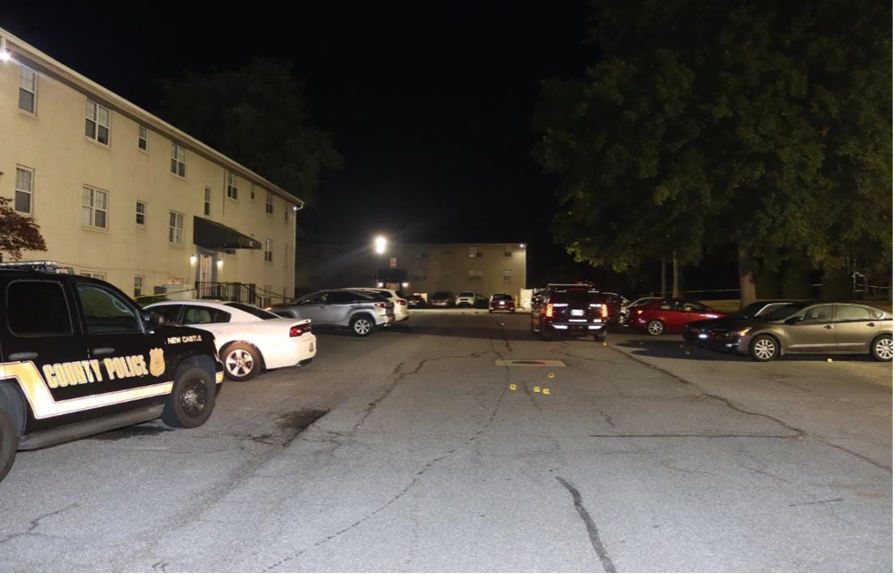



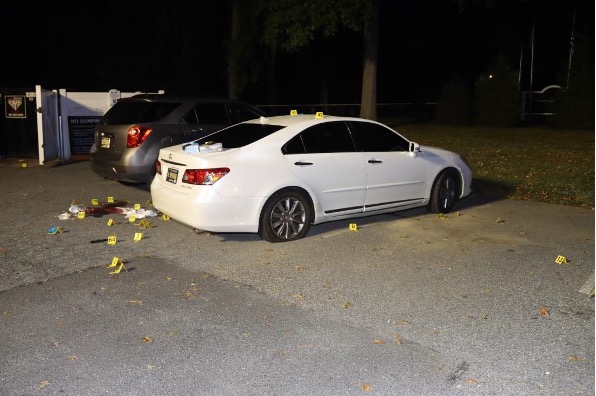
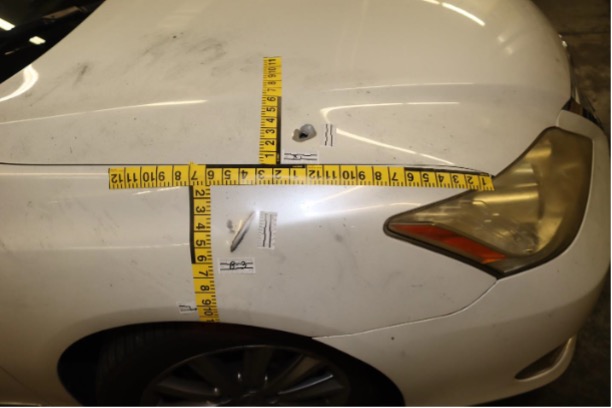

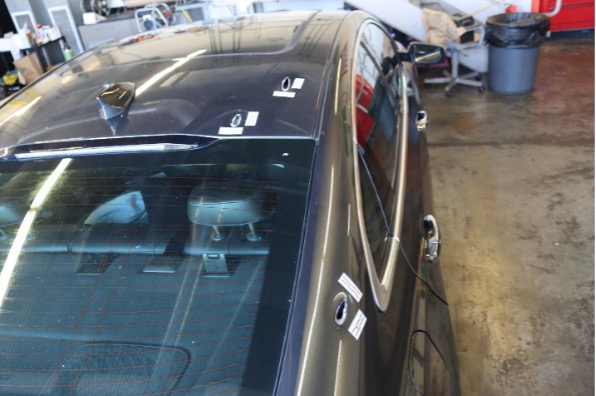
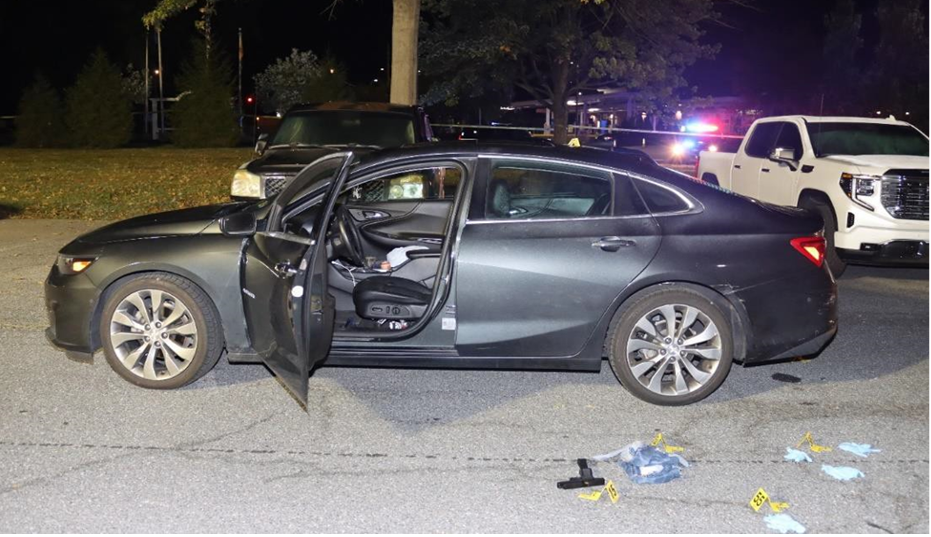
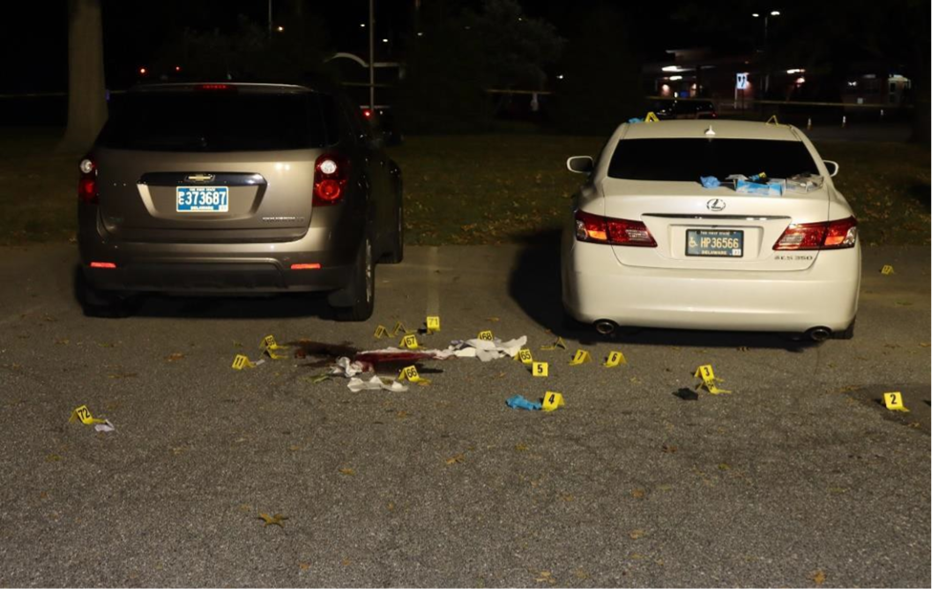
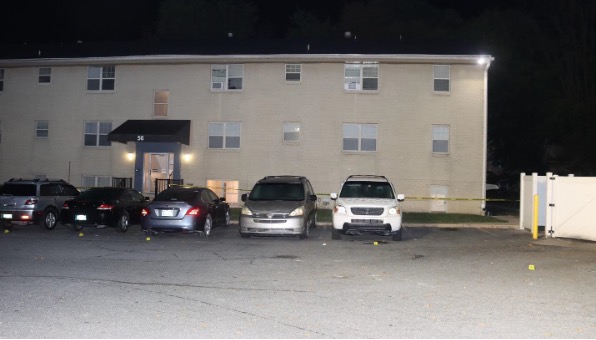
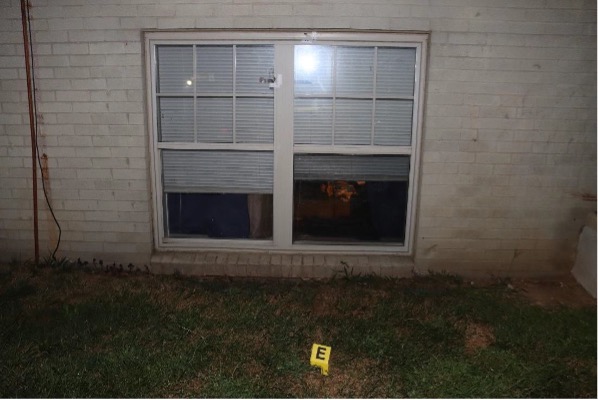
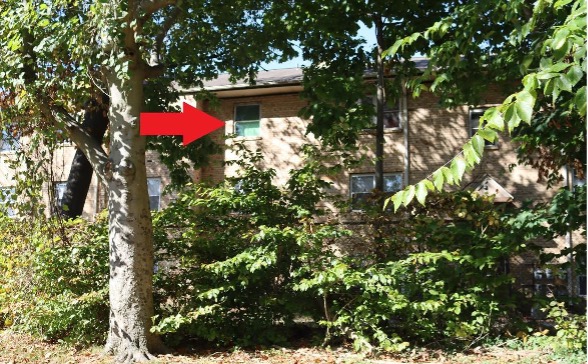

DNA Analysis
NCCPD obtained several swabs of Herndon’s firearm and sent them to the Division of Forensic Sciences for analysis. The testing confirmed that Herndon’s DNA was located on the weapon magazine release. Additionally, a combination profile was developed from the swabbing of the weapon grip. Herndon could be included as a contributor to this mixture.
Forensic Firearm Analysis
Herndon fired a total of nine rounds from her handgun (which appears to be a “ghost gun”), with the final round causing a failure to eject of the fired cartridge casing. Seven unfired rounds were located on the ground near V1. Additionally, a box of 9mm Blazer ammunition, consistent with the brand of fired and unfired cartridge casings recovered from the parking lot, was recovered from Herndon’s vehicle. FFSU analysis of the projectile recovered from V1 confirmed it was discharged from Herndon’s weapon.
Cpl. Fitzpatrick is believed to have fired twenty-one rounds from his Smith & Wesson M&P 9mm handgun. Ofc. Knight is believed to have fired four rounds from his SIG Sauer P32 9mm handgun.
Conclusion
The State must determine whether the use of deadly force by the NCCPD officers constitutes a criminal act. Title 11 Section 464 of the Delaware Code defines the legal use of force in self-protection. It provides, in pertinent part, that “[t]he use of deadly force is justifiable under this section if the [officer] believes that such force is necessary to protect the [officer] against death or serious physical injury.” In a criminal case, the State must also prove beyond a reasonable doubt that an officer’s use of deadly force was not justified under Title 11 Section 465, use of force for the protection of other persons.5
Under Delaware law, the objective facts and circumstances must be considered when determining whether the use of force was justifiable against another person, either in self-defense or in the defense of others. The specific factual inquiry is two-pronged. The first question is whether the Officers reasonably believed, at the time they intentionally fired their weapons, that such action was necessary to protect themselves or others from death or serious physical injury. The second question is whether the officers were reckless or negligent in having such belief, or in acquiring or failing to acquire any knowledge or belief, which is material to the justifiability of the use of force.6 If such force is determined to have been justified, the law requires an examination into whether such force negligently or recklessly created injury or risk of injury to innocent third parties pursuant to 11 Del. C. § 470(b).
In this case, the use of force by police was justified as a matter of law in both self-defense and in the defense of others. Herndon was armed, disobeyed police commands, fired multiple times at V1 while recklessly endangering others in the vicinity, faced officers while armed, and fired in their direction. But for police intervention, Herndon’s actions may have resulted in at least one homicide.
The police were not reckless or negligent in forming the belief that deadly force was immediately necessary in this case. Officer Fitzpatrick saw Herndon armed and standing over her victim. He acted quickly to intervene before Herndon turned and faced the police with her firearm – and fired.
Because the police were justified to use force pursuant to 11 Del. C. § 464, we further determine that they were not negligent or reckless in injuring or creating a risk of injury to third persons under 11 Del. C. § 470(b). The police were confronting an active shooter – Herndon shot V1 at close range and fired at the police. No third persons were injured by the police and the police took reasonable measures to only use force when necessary.
Finally, Delaware law requires that DCRPT’s public report on the use of force include the race of the law enforcement officer who used force, the race of the individual on whom force was used, and whether race was a relevant or motivating factor. Herndon, the person against whom force was used, is a Black female. V1, the person against whom Herndon directed force, is also a Black female. Officer Fitzpatrick is a white male and Knight is a white male. The evidence shows that race was not a relevant or motivating factor in the use of force.7 The relevant and motivating factors in the use of force by police were the reasonable belief that force was necessary due to the imminent danger and substantial risk of death that Herndon posed to others.
Upon careful consideration of the available evidence and the application of expert opinion to that evidence, Officers Fitzpatrick and Knight all reasonably believed that the use of deadly force upon Herndon was immediately necessary for the purpose of protecting another – and themselves. As a result, the Department of Justice concludes the use of deadly force in this case does not constitute a criminal offense under the laws of the State of Delaware.
Notes
1 In this case, Herndon survived her gunshot wounds and was indicted by a Grand Jury on two counts of Attempted Murder in the First Degree (one for Officer Fitzpatrick and one for V1), three counts of Reckless Endangering First Degree, one count of Possession of a Firearm During the Commission of a Felony, one count of Criminal Mischief, and two counts of Endangering the Welfare of a Child. An indictment is the charging document in a criminal case and does not itself constitute evidence of guilt.
2 A gun that lacks a serial number by which it can be identified and that is typically assembled by the user (from purchased or homemade components).
3 This response was documented under a separate New Castle County Police case number.
4 V1’s video recorded the initial encounter with Herndon, who is observed holding a handgun.
5 “(a) The use of force upon or toward the person of another is justifiable to protect a third person when: (1) The defendant would have been justified under § 464 of this title in using such force to protect the defendant against the injury the defendant believes to be threatened to the person whom the defendant seeks to protect; and (2) Under the circumstances as the defendant believes them to be, the person whom the defendant seeks to protect would have been justified in using such protective force; and (3) The defendant believes that intervention is necessary for the protection of the other person.”
6 11 Del. C. § 470(a)
7 If race were a relevant or motivating factor in any shooting, the criminal charging analysis would include discussion of Hate Crimes under 11 Del. Sec. 1304(b).
Supplements & Downloads
Documents
Additional Photos
Videos
Viewer discretion advised. Because of their graphic nature, these videos are age-restricted.
Video: Body-worn camera footage from Cpl. Fitzpatrick
Video: Body-worn camera footage from Ofc. Knight
Video: Cell phone footage from V1


